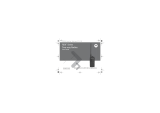
CONTENTS
English
2
Getting Started . . . . . . . . . . . . . . . . . . . . . .27
Turning radio ON/OFF. . . . . . . . . . . . . . . . . .27
Adjusting Volume . . . . . . . . . . . . . . . . . . . . .27
Selecting a Channel . . . . . . . . . . . . . . . . . . .27
Talking and Monitoring . . . . . . . . . . . . . . . . .27
Receiving a Call . . . . . . . . . . . . . . . . . . . . . .28
Talk Range . . . . . . . . . . . . . . . . . . . . . . . . . .28
Radio LED Indicators . . . . . . . . . . . . . . . . . .30
Hands-Free Use/VOX . . . . . . . . . . . . . . . . . .31
With Compatible VOX Accessories. . . . .31
Setting VOX Sensitivity. . . . . . . . . . . . . .32
Microphone Gain. . . . . . . . . . . . . . . . . . .32
Battery Save . . . . . . . . . . . . . . . . . . . . . .32
Reset to Factory Defaults . . . . . . . . . . . .32
End of Transmission Tone
(Roger Beep Tone) . . . . . . . . . . . . . . . . .33
Programming Features . . . . . . . . . . . . . . .34
Programming Mode. . . . . . . . . . . . . . . . . . . .34
Learning to Read the Values the
Radio Signals You . . . . . . . . . . . . . . . . .34
Entering Programming Mode . . . . . . . . .37
Reading Frequencies Values . . . . . . . . .37
Reading CTCSS/DPL Values . . . . . . . . 38
Reading Auto-Scan Values . . . . . . . . . . 39
Programming Frequencies, Codes
and Auto-Scan . . . . . . . . . . . . . . . . . . . . 39
Programming Mode FAQ. . . . . . . . . . . . 40
Programming Values Example. . . . . . . . . . . 41
Example of Programming a Frequency . 41
Example of Programming a Code . . . . . 42
Example of Programming Auto-Scan . . 43
Other Programming Features . . . . . . . . . . . 44
Scan. . . . . . . . . . . . . . . . . . . . . . . . . . . . 44
Editing Scan List . . . . . . . . . . . . . . . . . . 45
Nuisance Channel Delete . . . . . . . . . . . 45
CPS (Computer Programming Software). . . 46
Bandwidth Select . . . . . . . . . . . . . . . . . . 47
Time-Out Timer . . . . . . . . . . . . . . . . . . . 47
Power Select . . . . . . . . . . . . . . . . . . . . . 47
Battery Type Setting . . . . . . . . . . . . . . . 47
Call Tones . . . . . . . . . . . . . . . . . . . . . . . 47
Scramble . . . . . . . . . . . . . . . . . . . . . . . . 48
Reverse Burst . . . . . . . . . . . . . . . . . . . . 48
Cloning Radios. . . . . . . . . . . . . . . . . . . . . . . 49




















